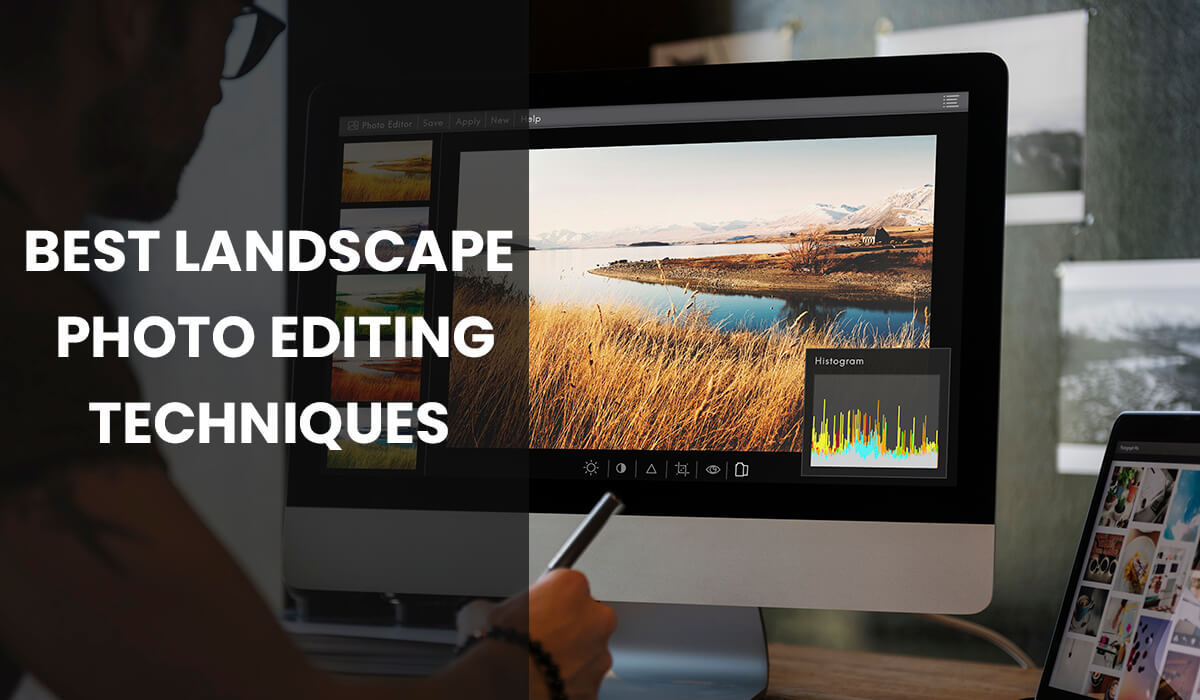The task of making a picture truly stand out does not end with merely clicking the photo, there’s much more to it. It’s not just about capturing what a property looks like; it’s about showing the dream, the lifestyle, and the possibilities it holds. Whether it’s a cozy suburban home with a lovely garden or a grand estate with stunning landscapes, the way you show the property’s surroundings bridges the gap between the tangible and the intangible, making it appealing to potential buyers.
To help you make the most of your property images, we’ll explore some of the proven photo editing techniques that can enhance the beauty of a property’s surroundings. From fixing crooked horizons to making gardens look more inviting, from capturing the magic of twilight to adjusting colors, we’ll guide you through the process of using photo editing to make property perimeters look their best, in an easy-to-understand way.
Top 8 Landscape Photo Editing Techniques
1. Horizon Straightening
Importance: A level horizon is crucial in landscape photos to maintain a professional and aesthetically pleasing appearance. It ensures that the property and its surroundings appear balanced, eliminating any unintended tilts that can distract viewers from the property itself.
Approach: In post-processing software like Adobe Lightroom or Photoshop, you can use the “Crop” or “Transform” tools to straighten the horizon manually. These tools offer gridlines and guides to help align the horizon perfectly.
2. Twilight Enhancement
Importance: Twilight or “golden hour” shots capture the property at the most enchanting time of day, with a warm, soft, and inviting light that can significantly increase a property’s visual appeal. These shots are particularly effective for showcasing outdoor spaces and landscape features.
Approach: To enhance twilight shots, adjust the white balance to emphasize warm tones, increase saturation to make colors pop, and apply soft lighting effects to create a cozy and inviting atmosphere. These enhancements can highlight outdoor amenities, gardens, and the overall charm of the property.
3. Panoramic Stitching
Importance: It is essential when showcasing large or wide properties. It allows you to combine multiple photos into a single, seamless view, providing potential buyers with a more comprehensive perspective of the property.
Approach: Specialized panoramic stitching software or features in photo editing software can help align and merge individual shots to create a panoramic image. You can adjust the blending and alignment settings to achieve the desired result.
4. HDR Toning
Importance: It is valuable when dealing with scenes that have extreme variations in lighting, such as a bright sky and shaded property. It helps balance the exposure and reveals more details in both the highlights and shadows, making the image visually appealing.
Approach: To create an HDR image, you’ll need to capture multiple exposures of the same scene, typically one underexposed, one correctly exposed, and one overexposed. Software tools can merge these exposures and offer controls to adjust the tonal range and create the final HDR image.
5. Walkway Lighting Adjustment
Importance: Emphasizing walkway lighting for evening shots creates a warm and inviting atmosphere, particularly for properties with outdoor amenities. It helps potential buyers envision the property’s charm at night.
Approach: You can brighten the walkway areas, adjust colors to create a warm glow, and use dodge and burn tools to enhance the lighting’s visual appeal.
6. Fence and Gate Editing
Importance: Fences and gates contribute to a property’s security and visual appeal. Editing them not only ensures they look well-maintained and attractive but adds attention to detail, by specifying aspects such as width and open angle, without compromising the property’s authenticity.
Approach: Use editing and reshaping tools to remove any blemishes or imperfections, adjust colors to make them appear vibrant, and enhance details for a more precise look.
7. Water Feature Highlighting
Importance: Properties with water features, such as ponds, pools, or fountains, can benefit by highlighting them to make the entire space more attractive and showcase a serene environment.
Approach: Adjust the lighting, colors, and clarity in the area surrounding the water to make it eye-catching while maintaining a natural and inviting look.
8. White Balance, Hue, and Saturation Adjustment
Importance: By working on white balance, hue, and saturation, you can significantly improve the overall appearance of the image. Proper white balance ensures accurate color representation while tweaking hue and saturation allows you to create a specific atmosphere and highlight key features.
Approach:
White balance: Correct the white balance to ensure that the colors in the photo appear natural and true to life. For instance, you can cool down a warm-toned image or warm up a cool-toned image to achieve the desired ambiance.
Hue: Adjusting the hue can shift the color tones within the image. For example, you can make greens appear more vibrant or shift the sky’s color from blue to purple for a dramatic effect.
Saturation: Controlling saturation levels allows you to make colors more vivid or muted. You can enhance the lushness of greenery, make a blue pool stand out, or tone down colors for a minimalist look.
Mistakes To Avoid While Editing Photos
A. Overprocessing
Concern: Excessive editing can make photos look unrealistic and unappealing. Overly bright or saturated colors, unnatural contrast, and over-sharpening should be avoided.
Solution: Strive for a natural and balanced look. Make subtle adjustments and refer to reference images to maintain authenticity.
B. Inconsistent editing
Concern: Inconsistency in editing styles and color balance among photos in a property portfolio can create a disjointed and unprofessional presentation.
Solution: Develop a consistent editing style and apply it uniformly to all photos in a property set. Use presets or templates to maintain consistency.
C. Rushing the editing process
Concern: Hasty editing can lead to oversights, missed opportunities, and subpar results. Time and attention are essential in the editing phase.
Solution: Allocate sufficient time for each editing session. Review and fine-tune your edits with a fresh perspective, ensuring the best possible outcome.
D. Overusing filters and presets
Concern: Excessive use of filters and presets can make photos appear generic and lack individuality. Overreliance on these shortcuts can lead to poor results.
Solution: Use filters and presets sparingly and adapt them to suit the specific needs of each property. Customize your edits to highlight the property’s unique characteristics.
E. Unrealistic color choices
Concern: Applying unrealistic or unconventional color choices to walls, furnishings, or outdoor elements can mislead potential buyers.
Solution: Maintain color accuracy and use editing to enhance natural colors rather than introduce unrealistic ones.
Best Tools For Editing Landscape Photos to Showcase a Property Effectively
- Adobe Photoshop
- Adobe Lightroom
- Capture One
- DxO PhotoLab
- Corel PaintShop Pro
- Skylum Luminar
- Pixlr
- Fotor
Seeking Professional Assistance for Maximum Benefits
While many photo editing tools are readily available and easy to install, it’s important to recognize that advanced functionalities within these tools often demand a certain level of expertise. Complex tasks such as intricate retouching, HDR processing, or color grading demand significant time and resource investment. Additionally, attention to detail is crucial to prevent any potential losses.




